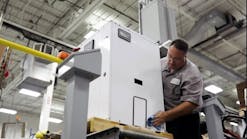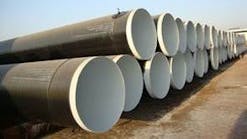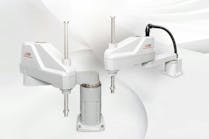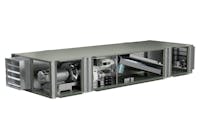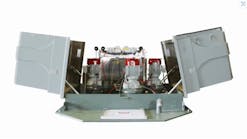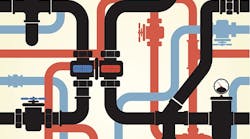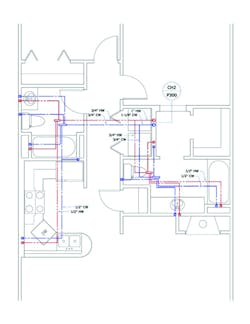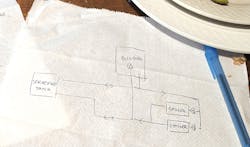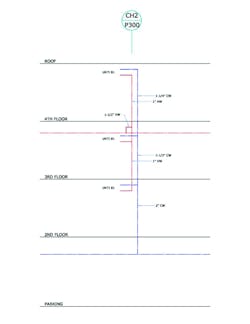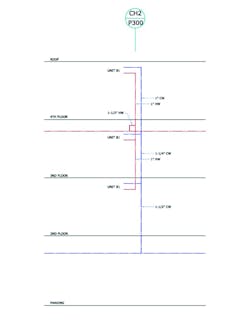Uponor, provider of cross-linked polyethylene (PEX) plumbing, indoor-climate, and fire-safety systems for residential and commercial buildings, recently completed a study comparing the cost-effectiveness of five types of plumbing piping for a multifamily building.
Material and labor costs were determined for the following system types:
- PEX.
- Chlorinated polyvinyl chloride (CPVC) trunk and branch.
- Copper press trunk and branch.
- Copper sweat trunk and branch.
- Polypropylene (PP-R) trunk and branch.
The building was a 517,550-sq-ft, 189-unit multifamily structure with three dwelling levels over a one-level parking garage.
The design had the main cold-water distribution routed in the parking garage and the main hot-water distribution routed in the third-floor ceiling, with risers transporting water up to the fourth floor and down to the second floor (figures 1 and 2).
Although the project called for pipe and fittings larger than 2 in., the study looked only at costs for pipe, fittings, and valves 2 in. and smaller.
Material costs were calculated at 2014 trade pricing values from across the United States.
Materials
For each system type, the following materials were included in the project costs:
PEX
- ½- to 2-in. Engel- or peroxide-method (PEX-a) pipe and ASTM F1960, Standard Specification for Cold Expansion Fittings With PEX Reinforcing Rings for Use With Cross-linked Polyethylene (PEX) Tubing, fittings.
- 1- to 2-in. pipe support channel with cable ties (except in units).
- 1- to 2-in. ASTM F1960 elbows.
- ½- to 2-in. ASTM F1960 commercial ball valves.
- Sweat adapters to transition to larger-diameter copper pipe.
- Engineered polymer multiport tees.
- Plugs at fixture terminations for lavatories, water closets, and sinks.
- ASTM F1960 outlet boxes for ice makers and washing machines.
CPVC
- ½- to 2-in. pipe and fittings (SDR-11 CTS).
- ½- to 2-in. elbows.
- Solvent-cement fittings.
- ½- to 2-in. commercial ball valves with threaded adapters.
- Caps at fixture terminations for lavatories, water closets, and sinks.
- Boxes for ice makers and washing machines.
Copper press
- ½- to 2-in. Type L pipe and press fittings.
- ½- to 2-in. press elbows.
- ½- to 2-in. commercial press ball valves.
- Caps at fixture terminations for lavatories, water closets, and sinks.
- Boxes for ice makers and washing machines.
Copper sweat
- ½- to 2-in. Type L pipe and fittings.
- ½- to 2-in. elbows.
- ½- to 2-in. commercial sweat ball valves.
- Caps at fixture terminations for lavatories, water closets, and sinks.
- Boxes for ice makers and washing machines.
PP-R
- ½- to 2-in. pipe and fittings, with a standard dimension ratio (SDR) of 11 for cold-water pipe and a SDR of 7.4 multilayer (MF) for hot-water pipe.
- ½- to 2-in. elbows.
- Socket-type fittings.
- ½- to 2-in. commercial ball valves with threaded adapters.
- Caps at fixture terminations for lavatories, water closets, and sinks.
- Boxes for ice makers and washing machines.
Labor
Labor was calculated using the Mechanical Contractors Association of America (MCAA) component-method approach. According to MCAA: “The component method is based on the use of labor units that represent all activities necessary for the installation of one component (such as a 90-degree elbow or a tee). For piping, the unit is in man-hours per foot, and for components such as fittings, the unit is represented by each. A labor unit is expressed in terms of man-hours to install a unit of material (such as a foot of pipe), an individual item (such as a fitting or valve), or perform a specific task (such as welding a joint).”
In developing the labor units, MCAA reviewed many aspects of installation, including:
- Receiving.
- Unloading.
- Stockpiling.
- Distribution.
- Handling and erection.
- Fitting and joining.
- Pressure testing.
Labor costs were calculated using a rate of $75 per hour, based on extensive research of labor rates across the United States.
Study Results
Material and labor costs were determined by building section:
- Main piping, which included all pipe and fittings 2 in. and smaller that were part of the horizontal cold-water distribution system on the garage level and the hot-water system on the third level.
- Unit piping, which included all pipe and fittings within units after the riser branch. Unit costs included hot- and cold-water isolation valves. Fixture terminations were plugged or capped for rough-in.
- Riser piping, which included all vertical piping and fittings. For cold-water risers, the piping started in the parking garage and rose roughly 30 ft to the fourth floor. For hot-water risers, the piping started in the third-floor ceiling space and was distributed 10 ft up to the fourth floor and 10 ft down to the second floor. Riser costs included isolation valves at the base.
Table 1 shows estimated labor hours for the individual building sections.
Table 2 shows the total project cost.
Individual-Unit Comparison
Material and labor costs were broken down at an individual-unit level. Figures 3 and 4 show unit piping. Table 3 shows the labor hours required to pipe a unit. Table 4 shows the total costs of piping a unit.
Individual-Riser Comparison
The labor required for an individual riser is shown in Table 5. Table 6 shows the total costs of piping a riser.
This report was prepared by Daniel Worm, plumbing-product specialist for Uponor. Worm has more than 14 years of plumbing-industry experience, with an emphasis on application and design. He is a licensed building contractor, a certified plumbing designer, and a member of the American Society of Plumbing Engineers. He holds a degree in architectural design and drafting. He can be reached at [email protected].
